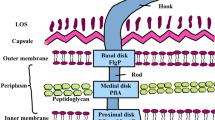Abstract
The inhibitory effect of three berberine alkaloids (BAs) from Coptis chinensis Franch, a traditional Chinese medicinal (TCM) herb, on Bifidobacterium adolescentis growth was investigated by microcalorimetry. The power-time curves of B. adolescentis with and without BAs were acquired, meanwhile the extent and duration of inhibitory effect on the metabolism were evaluated by the growth rate constant (k), half inhibitory ratio (IC50), maximum heat-output power (P max), peak time of maximum heat-output power (t p) and total heat production (Q t). k, P max and Q t decreased, and t p was prolonged with the increase of BAs concentration. The IC50 of BAs is 806 μg/mL for berberine, 341 μg/mL for coptisine and 236 μg/mL for palmatine. The sequence of antimicrobial activity of BAs is berberine < coptisine < palmatine. Combined with previous studies, it could be shown that the sequences of antimicrobial activity of BAs on both Bacillus shigae and Escherichia coli are berberine > coptisine > palmatine. The structure-function relationship of BAs indicates that the functional group methylenedioxy or methoxyl at C2 and C3 might be the major group inducing the activities of BAs on E. coli and B. adolescentis. Meanwhile, the substituent groups at C2, C3, C9 and C10 almost have equal effect on B. shigae.
Similar content being viewed by others
References
China Pharmacopoeia Committee, Pharmacopoeia of the People’s Republic of China (in Chinese). 1st Div. Beijing: China Chemical Industry Press, 2005. 213–214
Ding Z M. Pharmacodynamic Action & Clinic of Chinese Medicinal Materials (in Chinese). Beijing: China Medicine Technology Press, 1999. 54–56
Guo X H. Foundation & Application of Probiotics (in Chinese). Beijing: Beijing Science & Technology Press, 2002. 7–10
Ingemar W. Isothermal microcalorimetry in applied biology. Therm Acta, 2002, 394(1): 305–311
Shen X S, Liu Y, Zhou C P, et al. Thermochemical studies on the quality antibacterial effect relationship of fluorquinolones. Acta Chim Sin (in Chinese), 2000, 58(11): 1463–1466
Ingemar W. Isothermal microcalorimetry for the characterization of interactions between drugs and biological materials. Therm Acta, 1995, 267: 45–59
Graham B. Applications of isothermal microcalorimetry in the pharmaceutical sciences. Therm Acta, 1995, 248:117–129
Wu Y W, Gao W Y, Xiao X H, et al. Calorimetric investigation of the effect of hydroxyanthraquinones in Rheum officinale Baill on Staphylococcus aureus growth. Therm Acta, 2005, 429(2): 167–170
Xie C L, Tang H K, Song Z H, et al. Microcalorimetric study of bacterial growth. Therm Acta, 1988, 123: 33–41
Yan D, Xiao X H, Jin C, et al. Microcalorimetric investigation of the effect of berberine alkaloids from Coptis chinensis Franch on Staphylococcus aureus growth. Sci China Ser B-Chem, 2008, 51(7): 640–645
Katarzyna L, Bartlomiej P, Jerzy D. Microcalorimetry as a possible tool for phenanthrene toxicity evaluation to eukaryotic cells. Therm Acta, 2004, 411(2): 181–186
Liu Y, Yan C N, Wang T Z, et al. Kinetics of the toxic action of Pb2+ on Rhizopus nigricans as studied by microcalorimetry. Therm Acta, 1999, 333(2): 103–108
Tan A M, Huang Y Q, Qu S S. Determination of the respiratory burst of polymorphonuclear leukocytes by microcalorimetry. J Biochem Biophys Methods, 1998, 37(1): 91–94
Tan A M, Xie C L, Qu S S. Microcalorimetric study of mitochondria isolated from fish liver tissue. J Biochem Biophys Methods, 1996, 31(3): 189–193
Liu Y, Tzitschung T, Tahn C Z, et al. Microcalorimetric studies on the metabolism of Chlorella vulgaris. Chemosphere, 2000, 40(8): 845–849
Liu G S, Liu Y, Chen X D, et al. Study on interaction between T4 phage and Escherichia coli B by microcalorimetric method. J Virol Methods, 2003, 112(1): 137–143
Hu C Q, Liu Y N, Wang S M, et al. A microcalorimetric study on the effect of inhibitors on enzyme: Determination of inhibition constant k i. Chin Sci Bull, 1984, 29(5): 610–610
Yan D, Jin C, Xiao X H, et al. Investigation of the effect of berberins alkalokds in Coptis chinensis Franch on Bacillus shigae growth by microcalorimetry. Sci China Ser B-Chem, 2007, 50(5): 638–642
Yan D, Jin C, Xiao X H, et al. Antimicrobial properties of berberines alkaloids in Coptis chinensis Franch by microcalorimetry. J Biochem Biophys Methods, 2008, 70(6): 845–849
Li X, Liu Y, Wu J, et al. Microcalorimetric study of Staphylococcus aureus growth affected by selenium compounds. Therm Acta, 2002, 387(1): 57–61
Su X Y. Biological Fingerprinting Analysis for Probing the Interaction of DNA and Extracts of Traditional Chinese Medicines (in Chinese). Dissertation for the Doctoral Degree. Dalian: Dalian Institute of Chemical Physics, Chinese Academy of Sciences, 2006. 58–64
Author information
Authors and Affiliations
Corresponding author
Additional information
Supported by the National Natural Science Foundation of China (Grant Nos. 30625042 and 30873385) and Key Projects of National Science & Technology Pillar Program of China in the 11th Five-Year Period (Grant No. 2007BAI40B05)
About this article
Cite this article
Yan, D., Wei, L., Xiao, X. et al. Microcalorimetric investigation of effect of berberine alkaloids from Coptis chinensis Franch on intestinal diagnostic flora growth. Chin. Sci. Bull. 54, 369–373 (2009). https://doi.org/10.1007/s11434-009-0001-1
Received:
Accepted:
Published:
Issue Date:
DOI: https://doi.org/10.1007/s11434-009-0001-1




